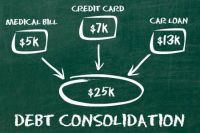If you have several debts such as Credit Card, Mortgage, Line of Credit and Personal Loan, chances are these each has a different interest rate. If possible, you can “pay off” the higher interest debts by adding more debt to the lower interest ones.
For example, if you have $5,000 debt on your credit card at 16% interest, and have a line of credit @ 7% interest with $9,000 (but it has room for $20,000) it would be in your best interest to pay off the credit card debt by adding $5,000 to your line of credit.
If you have several debts such as Credit Card, Mortgage, Line of Credit and Personal Loan, chances are these each has a different interest rate. If possible, you can “pay off” the higher interest debts by adding more debt to the lower interest ones. For example, if you have $5,000 debt on your credit card at 16% interest, and have a line of credit @ 7% interest with $9,000 (but it has room for $20,000) it would be in your best interest to pay off the credit card debt by adding $5,000 to your line of credit. Thus you’d eliminate the higher interest debt, and be left with the same total debt amount, but overall at a lower interest rate. This is good stuff! Interest will always get you over time, so any way to minimize it on your debts is a good thing.
If you cannot do this because you are maxed out on your low-interest debts or for whatever reason, you should do the following:
It’s the big thing these days… this loan consolidation. In most ways, it makes a lot of sense.
- pay the minimum amount on all debts except for the highest interest one
- pay as much as you can every payment on the highest interest debt
- when that highest interest debt is paid off, take all the money you were paying towards it and pay it towards the next highest interest debt
- follow this pattern until all debts are paid off
This process can be tracked with a simple manual debt elimination calendar or with more powerful tools like CalendarBudget

Leave A Comment